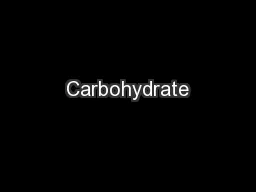

Counting and Basic Nutrition An education program for the person with diabetes Presented by Lisa Cogbill RD LD CDE Objectives Meal Planning What is a Carbohydrate Food Choices ID: 234171
Download Presentation The PPT/PDF document "Carbohydrate" is the property of its rightful owner. Permission is granted to download and print the materials on this web site for personal, non-commercial use only, and to display it on your personal computer provided you do not modify the materials and that you retain all copyright notices contained in the materials. By downloading content from our website, you accept the terms of this agreement.
Slide1
Carbohydrate Counting and Basic Nutrition
An education program for the person with diabetes Presented by: Lisa Cogbill, RD LD CDESlide2
Objectives:Meal PlanningWhat is a CarbohydrateFood ChoicesLabel ReadingImportance of NutritionSlide3
Keeping the Body HealthyNutrition Management of Type 1 Diabetes MellitusHealthy nutrition provides enough energy (or calories) for growth anddevelopment and allows for normal activities of daily living and exercise.Meal planning is part of your everyday life.The key to success is balancing: Food Insulin ExerciseHealthy choices with heart healthy meals are good for all individuals withand without diabetes. The needs will vary with age, sex, weight, and activity level.Slide4
THE 3 FOOD GROUPSCarbohydratesProteins FatsMeal planning for type 1 diabetes is based on carbohydrates.Carbohydrates raise blood sugar. In people with type 1 diabetes, we giveinsulin based on the carbohydrates that are eaten.The total amount of carbohydrates, protein, and fat in the meal plan will vary for individuals. Slide5
Protein Protein is a part of every cell in the body. Protein is needed for growthand repair of the body. Important enzymes and hormones are also proteins.Good sources of protein are:MeatsCheesesNut ButtersBoth the amount and quality of the protein are important. Fortunately,most individuals in the United States eat enough protein.All individuals need to include carbohydrate, fat, and protein in their diet.
For the person with type 1 diabetes, we focus on carbohydrates and knowing how many grams of carbohydrate we eat at meals and snacks.Slide6
FatsFats have an important role in a healthy meal plan. For example, vitamins A, D, E, K and carotenoids are fat-soluble.This means that fat is required for their digestion and absorption.Fats provide energy, which is important for individuals to growappropriately. Fats keep the brain and nervous system functioning normally andhelp maintain healthy skin.There are many different types of fat that have different effects oncholesterol and cardiovascular health.Saturated Fat –They are found mainly in animal-based foods
such as meat, poultry, butter, whole milk and whole milkproducts, and from coconut, palm and palm kernel oils.Monounsaturated Fat – Canola oil, olive oil, avocado oil and nutsPolyunsaturated Fats- Corn, safflower, soybean, sesame, sunflower, peanut, walnut, fish, and flaxseed oilsSlide7
Eat RightCarbohydrates are the primary foods that affect glucose levels.Foods with CarbohydratesBreads, crackers and cerealsPasta, rice and grainsStarchy vegetables, such as potatoes, corn and peasNon-starchy vegetables such as broccoli, salad greens and carrots Milk and yogurt
Fruits and juicesSweets and dessertsSlide8
Straight to your blood streamSlide9
CARBOHYDRATE COUNTINGCarbohydrate counting is important for meal planning when you have diabetes.Knowing how much carbohydrate you eat helps you determine how much insulin you will need.Counting the total grams of carbohydrate in meals and snacks helps you eat about the same amount of food.Eating the same amount of carbohydrate, but from different foods, have an effect on blood sugar.Slide10
MASTERING THE SYSTEMAfter you know what type of foods contain carbohydrates you need to know exactly how much it contains. Food labels, nutrient analysis apps and books, and learning portion sizes are all tools that can help you become accurate. Slide11
Tools and tips Slide12
Tools and TipsSource: Adapted from Warshaw, H.S., Bolderman,K.M.: American Diabetes Association Practical Carbohydrate Counting: A How-To-Teach Guide for Health Professionals., Alexandria, Va., Copyright © 2001 American Diabetes Association.Slide13
Counting carbs: Check the label Serving Size: The portion for which nutritional facts are calculated. Total Carbohydrates: Includes grams of sugar, sugar alcohol, starch, dietary fiber.Slide14
Calculate a snackHow many carbs are in 4 crackers?4 crackers = 2 servings
2 servings x 10 grams per serving =20 grams of carbsSlide15
Your turn …How much is one serving?How many grams of carbs are in one serving?If you eat one cup, how many carb exchanges is that?Slide16
YOUR TURNHow many grams of carbs in a 6 inch turkey sub?How many carbs in 60 fries?
How many carbs in 1 cup of cooked green beans?How many carbs in 1 cup raw broccoli?How many carbs in 1 piece of bubble gum?How many carbs in Moms homemade Chicken Pot Pie?Slide17
Chicken Pot Pie Reciperecipe makes 1 - 9 inch pie1 pound skinless, boneless chicken breast halves1 cup sliced carrots 1 cup frozen green peas 1/2 cup sliced celery 1/3 cup butter 1/3 cup chopped onion
1/3 cup all-purpose flour 1/2 teaspoon salt 1/4 teaspoon black pepper 1/4 teaspoon celery seed 1 3/4 cups chicken broth 2/3 cup milk 1 (9 inch) unbaked pie crusts Carb content in recipe1 cup carrots – 5g1cup peas – 30 gcelery and onion– 5 grams
1/3 cup flour -30 grams
2/3 cup milk – 8 grams
1 pie crust -96 grams
Total Carbs = 174
Total serving in pie = 8
Total for 1 serving= 174/8=21.75
22 grams CarbsSlide18
You are what you eat.The freedom of carb counting can increase the temptation to overeat—which inevitably leads to weight gain.Remember to eat at least 3-5 servings of vegetables and 2-3 servings of fruit.Slide19
RD VisitsIt is recommended that all people with type 1 diabetes mellitus see a registered dietitian at least once a year. A dietitian can provide specific details on calorie, carbohydrate, and fat needs. They will also provide nutrition counseling to help manage blood sugars and to promote health and wellnessSlide20
Knowledge is powerAny questions?Thank you!!!!